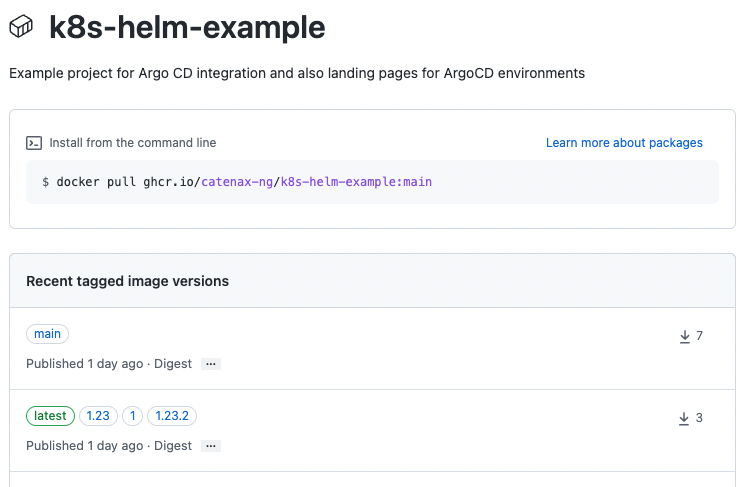TRG 4.01 - Image tagging
| Status | Created | Post-History |
|---|---|---|
| Active | 20-Mar-2024 | update example workflow for TRG 4.08 |
| Active | 11-May-2023 | update example workflow to match TRG 4.05 |
| 24-Nov-2022 | more precise process description | |
| 10-Nov-2022 | Initial release |
Why
Using non-specific image tags like :latest would require everyone to find and check long hashes instead of a version number.
This also breaks control of selecting specific versions and upgrading as :latest would pull in new images on restart of a pod.
Container image tagging also helps you to match TRG 5.05 - Chart Values.
Description
The build process for container images must ensure proper image tagging. All images must be tagged
following semantic versioning, e.g. :0.1.2 as well as the latest image must be tagged in
addition with :latest.
Process example description
If you follow our recommendation how to create container images and tag them, the following list describes the process steps:
-
Create/edit your
Dockerfileand merge Changes via PullRequest tomainbranch, if changes where made in a feature branch, or similar. -
Create/push a Git tag to
mainbranch, e.g.:> git pull
remote: Enumerating objects: 129, done.
remote: Counting objects: 100% (84/84), done.
remote: Compressing objects: 100% (65/65), done.
remote: Total 129 (delta 29), reused 11 (delta 10), pack-reused 45
...
> git tag -a v1.2.3 -m "annotation text goes here"
> git push origin v1.2.3cautionGit CLI will create tag on the latest (local) commit. Ensure to be up-to-date with the remote after, otherwise use commit ID while creating the tag.
tipPrefer annotated tags over lightweight tags. Refer to Git documentation about tags.
-
Pushing the tag will trigger the GH workflow to build your Docker image
-
After the finishing the build workflow, your repository will contain proper versioned Docker images, e.g.:

Implementation
Create a GitHub Workflow file with following content:
name: Build - Docker image (SemVer)
on:
push:
branches:
- main
# trigger events for SemVer like tags
tags:
- 'v*.*.*'
- 'v*.*.*-*'
pull_request:
branches:
- main
env:
IMAGE_NAMESPACE: "tractusx"
IMAGE_NAME: "YourApplicationName"
jobs:
docker:
runs-on: ubuntu-latest
permissions:
packages: write
steps:
- name: Checkout
uses: actions/checkout@v3
# Needed to create multi-platform image
- name: Set up Docker Buildx
uses: docker/setup-buildx-action@v2
# Create SemVer or ref tags dependent of trigger event
- name: Docker meta
id: meta
uses: docker/metadata-action@v4
with:
images: |
${{ env.IMAGE_NAMESPACE }}/${{ env.IMAGE_NAME }}
# Automatically prepare image tags; See action docs for more examples.
# semver patter will generate tags like these for example :1 :1.2 :1.2.3
tags: |
type=ref,event=branch
type=ref,event=pr
type=semver,pattern={{version}}
type=semver,pattern={{major}}
type=semver,pattern={{major}}.{{minor}}
- name: DockerHub login
if: github.event_name != 'pull_request'
uses: docker/login-action@v2
with:
# Use existing DockerHub credentials present as secrets
username: ${{ secrets.DOCKER_HUB_USER }}
password: ${{ secrets.DOCKER_HUB_TOKEN }}
- name: Build and push
uses: docker/build-push-action@v3
with:
context: .
# Needed to create multi-platform image
platforms: linux/amd64, linux/arm64
# Build image for verification purposes on every trigger event. Only push if event is not a PR
push: ${{ github.event_name != 'pull_request' }}
tags: ${{ steps.meta.outputs.tags }}
labels: ${{ steps.meta.outputs.labels }}
# https://github.com/peter-evans/dockerhub-description
# Important step to push image description to DockerHub
- name: Update Docker Hub description
if: github.event_name != 'pull_request'
uses: peter-evans/dockerhub-description@v3
with:
# readme-filepath defaults to toplevel README.md, Only necessary if you have a dedicated file with your 'Notice for docker images'
# readme-filepath: path/to/dedicated/notice-for-docker-image.md
username: ${{ secrets.DOCKER_HUB_USER }}
password: ${{ secrets.DOCKER_HUB_TOKEN }}
repository: ${{ env.IMAGE_NAMESPACE }}/${{ env.IMAGE_NAME }}